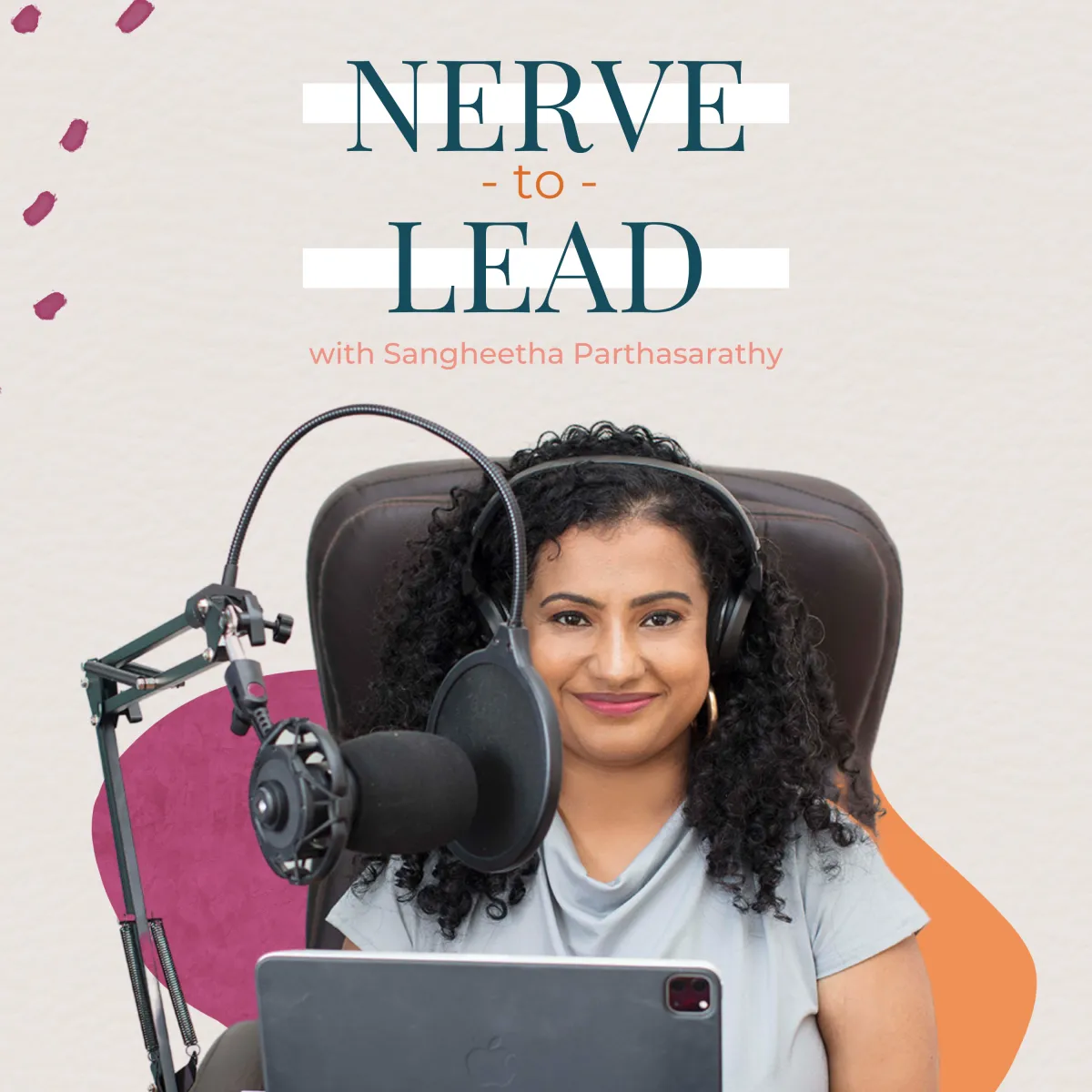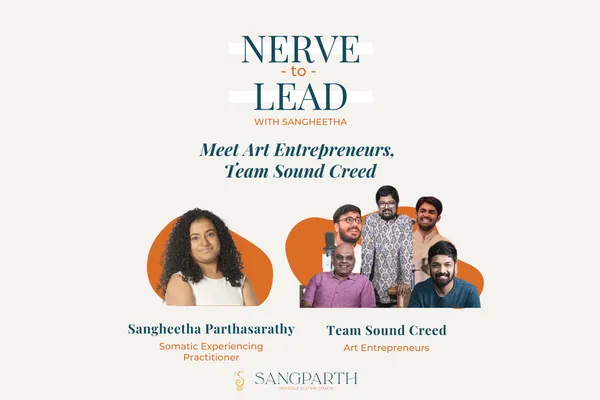The Nerve To Lead Podcast
with Sangheetha Parthasarathy
On The Nerve to Lead podcast, your host, Sangheetha Parthasarathy encourages CEOs, Entrepreneurs, deep thinkers, the round-pegs-in-square-holes, change-makers and visionaries to share their stories of power, pleasure and passion.
We cover everything from nervous system regulation, high achievement, trauma healing, parenting, partnership and attachment, intimacy and more. You will also get to learn the stories and knowledge from our expert guests and thought leaders.

Apply to be a guest on
Nerve to Lead Podcast
Welcome to 'Nerve to Lead' podcast. Apply here to be a guest on the podcast with Sangheetha Parthasarathy.
Invite Sangheetha as a
guest to your podcast
Invite Sangheetha, a Nervous System Coach, Speaker and Consultant to be a guest on your podcast.

Meet Art Entreprenuers , Team Sound Creed.
Join us in this captivating episode as we delve into the creative process behind crafting an extraordinary album that intertwines global sounds with a captivating carnatic core. "Perumal and Providence" is unlike any other, as we flow freely through discussions on Bhakti, embodiment, and so much more. Tune in for an inspiring and enriching experience!
EPISODE TRANSCRIPTION:
Welcome to the Nerve to Lead podcast. Here we explore power, pleasure, leadership, identity, belonging, parenting, and couplehood, and explore stories of navigating through life, finding both authenticity and attachment through the common lens of the nervous system. I am your host, Sangheetha Parthasarathy and I'm so glad you're here.
Sangheetha Parthasarathy: Today I'm joined by team Sound Creed and all the artists and people behind the production of Perumal and Providence. Just a beautiful work in Carnatic music and Bhakthi And for me personally, this is very evocative, very, very deeply emotionally stirring. And so I'd love for us to talk, so maybe I'll start with Aditya who runs Sound Creed, which is an independent introduction. Yeah. So tell us a bit more about how this came about.
Aditya Balasundaram: I wanted to make my dad a birthday album, So me and Sumesh were going back and forth about it for a while. And I told him, basically, let's do an instrument only album, all instrumental album. And I said, I'll give you the songs that I want to be sung or played. And I said please take full creative liberty to do whatever you want with the songs, but six songs I wanted in Carnatic style traditional way. And the other six songs, we said, please play with it. I just told him that, except for Chakkanai Raja (song name) , I said, it has to be in "Mallari" style. Besides that, it was all him. And then the process just went on. We added Pasurams (Devotional script) which relate to those particular songs. And then I met Ashwath and Bharat and I really wanted both those voices there then that's how, Amalanadhipiran (song name) and Thirunedunthandagam (song name) were born and that's how it was going. And once we started doing things, then I said, why don't we start a music company? So Sumesh, Ravi and I started Sound Creed that's how it was Born.And Sumesh, I'll let you expand.
Sumesh: Please sum pretty much the gist Sangheetha I also realized the pitch, the requirement was was mammoth in the sense that you know, a lot of time, effort, and a lot of artists, a lot of musical efforts had to come together to actually make something like that. Because it really did sound like like a big project both in terms of the time involved, because see, one of the first things that you think about cutting a record is how much time you are demanding the audience to dedicate to listening to it. Okay. That's a very important. In today's time when we are looking at three minute, three and a half minute YouTube videos that, sort of dictate a certain trend. And if you don't have a listener, if you don't have a viewer in the first 10, 15 seconds, then you've lost them. So, while discussing all of that, we realized that this album, was going to be easily about over 200 minutes if I'm not wrong. And that's a lot of time to be demanding from someone who'd be listening to it. So then we realized we should chop it into pieces. We cannot have it as one long A to Z kind of a thing, So that came about and then we realized, these songs were all time tested. These have stood the, you know, test of time, it's been around for a few hundred years, and how we could possibly package it so that both sides of our target market, which was essentially obviously the known Carnatic music industry from the audience perspective, that has listened to these songs and knows these songs by heart. They know the meaning of the songs, they know the context of the songs, you're dealing with a very intellectual audience at one hand. And on the other hand, you have this, extremely, extremely untouched market where contemporizing, something as classical as this hasn't really taken place. I wouldn't say it has never, there have been a lot of efforts and this is nothing new that we've done, but I'd like to believe that, the space that we've sort of achieved with this album is spot on. It is very cohesive. At least to my knowledge, I haven't come across a lot of experiments, a lot of contemporary experiments have been done on, on basically classical presentation being contemporized at some level, be it the arrangement, be it the presentation, be it the whole dealing with concepts kind of a thing. But, I think the biggest strength of an album like this was the vision that was Aditya's to take Perumal Keerthanais and put it together. And sort of Ravi and I came into the project and we realized, we decided that it cannot just be one whole thing, and it needs to have facets. And when we have artists like, ashwath and Bharat and Sayee and many, many more artists coming into the album, we thought we should really just, you know, push this. And because the artists that were also part of the album were not just singers and instrumentalist. Each and every artist was a producer in his or her own right. So we wanted to see how everything could just come into place but not seem crowded and all that. So we reserved six of these songs to have each of their own sonic worlds, so to speak, sonic environments where in my mind at some level Perumal was envisioned as a different subject in each, for example, Chakkani Raja (song name) he was sort of looked at as this alpha farmer in a village where he's not seen as a God or anything. He's just seen as a very righteous man who lived among these folks in the village. And every time he walked across these fields, every time he was present, they felt, something really, really, powerful and so Raja Margam trying to draw a parallel there. In Soundararajam (song name) Perumal was a very evocative form. There is no form. He's not seen as a man, or he's not seen as a being. He's seen as an energy, right. So we wanted to see if you could just listen to it and sort of be transported to a different place altogether. Mundu Venuka (song name) is like this, you know, he's just rocking the streets of Chennai or wherever you want, and we had this very pop arrangement and obviously, O Rangasayee (song name) was this very, very, caressing very soft being that, that, he's a friend that you can, rest your head on, like a shoulder. He's always there when you wanna just like, sort of confide in him for whatever reason. So these visions sort of helped the sonic environment that we were going for. And I think we sort of nailed it.
Sangheetha Parthasarathy: Oh, absolutely. I think the thing that you talked about is contemporizing something classical. I think what also added to a couple of Amalanadhipiran (song name) and the other, it is also Tamil the language and the whole treatment. And what you talked about with having an intellectual audience versus somebody who just wants to listen to music. And I think that you really nailed that part because, even for somebody who does not listen to Carnatic music on a regular basis, this brings them into the listening. Like my husband is not a regular Carnatic music listener, but he also grew up with his dad chanting it like chanting it, when he prays, therefore he knows the words, but he's never heard it being sung like this. And then that brings out something very deep. I think. So, yeah. talk to us about process. So Ashwath and Bharat, I think you're choosing the Ragams (a melody which is created with notes) and putting it together.
Bharat: Hi. Hi, Sangheetha
Sangheetha Parthasarathy: hi.
Bharat: Okay. So, the most important thing was all of us let the content decide the form. We did not come from the space of like, we want a song for two minutes, and it wants, we wanted to be an instant hit, or we want like, people to like, share it and trend it. That was not our aim. We wanted to do some music. And thanks to the Pandemic, we had a lot of time, we sat together, Had fun, Had fun, had loads of fun, like, yeah, loads of fun. That's for a separate podcast, yeah, that's how the whole album happened. With respect to Amalanadhipiran (Song name) which I tuned. Thirunedunthandagam (Song name), Ashwath tuned it. Yeah. And we talk about that. Amalanadhipiran (Song name) see the whole, the context of the song is very beautiful. So there is this man Thirupanazhvar . Long story cut short was he was a musician and he was singing, on the streets of Srirangam and he did not, he felt he was too low to go into the temple or into the streets of Srirangam, in fact. And then Legend has said that Perumal came in the dreams of one of the Archagars or one of the people who did Puja (the act of worship), and asked him to like, lift him on his shoulders and come, because he wouldn't step into Srirangam. So, so he does that, and he comes and he just sings the 10 songs. And in the final verse, he says, and then he just surrenders or he attains Mukthi (salvation). That is the legend. That's the story. So that's the whole, so from the first verse till the last verse, he describes, every body part of Perumal (The god).
Sangheetha Parthasarathy: Yes, yes. It is a very embodied, and when you think about spirituality and Bhakthi (devotion and love for a personal god) being like an intellectual, thing. But when you look at this literature, especially Bhakthi literature, it is very embodied and sensual almost, because there are so many ways that the chest is described, the heart is described, the eyes are described. The feet are described. Exactly. yeah.
Bharat: The jewellery, yes. Everything, everything. And this song is almost like it goes from the physical to the metaphysical, or it transcends like by describing every aspect, and it goes to like, attain Mukthi (salvation) something like that. And tuning the song, only thing that I had in mind while setting this to tune was, two verses that comes back to back. The ragam should not like really clash, or one should like, lead into other. And that was absolutely taken care by these guys Sayee Rakshith, Ravi and Sumesh like flowing from one ragam to another ragam, it was mind boggling to Phenomenal.
Sangheetha Parthasarathy: Yes. Oh my God. Yeah. And also the global sounds Suddenly there is a little Scottish bit that's there. And its totally like, you're completely immersed in that experience, I feel like.
Bharat: Yeah. For example, there is a Varali (a rāgam in Carnatic music) yes! Where they would've, like, they would've like completely gone electronic.
Sangheetha Parthasarathy: Yes.
Bharat: No, nobody would've even thought of it.
Sangheetha Parthasarathy: Exactly. First time I head the Varali, I was thinking, wow, I've never heard of this kind of Varali ever.
Bharat: Yeah, what was that line? It goes like full, full on like board.
So I mean, all credits to these guys and the way the whole percussion was handled. Some places, for example, the final verse where he says the percussion builds it up. Yes Stops there. Then just the violin comes. Beautifully scripted.
Sangheetha Parthasarathy: Yeah. I just love also the ragam selection I think there was a good mix of, you started with Ranjani (a rāgam in Carnatic music) and it was amazing. It's like, yes. I think there was a good mix of more the evocative ragams and a little more, what you call gana ragams The treatment was fascinating. And then the way it flows with the emotion, being tuned for that, and then having a whole supportive kind of soundscape around that,
Bharat: I don't know, the soundscape was completely built by these three gentlemen, Ravi G, Sumesh and Sayee Rakshith and that's what there are two things. One is we work together, like we lived together. Literally the two, three months of pandemic, we actually literally lived together. And the second thing is, we did not have the end product in mind and work towards it. We just let the song evolve.
Sangheetha Parthasarathy: Yeah. And I think that's what I think what you said about having your first principles, right? That you were not trying to trend it, you were not trying to get to a million or whatever views or whatever, but you were just trying to create good music. I think that it shows in the work, right? I think for the audience, it reaches your target market. Yeah. yeah. Ashwath, do you want to talk about your process?
Ashwath: Yeah, sure. So, when the project was being discussed, so the two works were already decided, Thirunedunthandagam and Amalanadhipiran (song names) and it was left to me and Bharat to kind of decide who picked what And what happened was I had not read both the works, but what was told was, Amalanadhipiran (song name) does not have a meter that it follows and difficult to tune and other things. So I, without even thinking, like, pushed it to Bharat and said, you please take care of that. And I took the other one without even reading it. Then I realized that Amalanadhipiran are four line Pasurams, and mine was eight line Pasurams Nedunthandagam the big eight line ones. So eight into 10, so 80 lines I had to tune.
Bharat: So when Ashwath gave it to me, I took it very happily,
Ashwath: so that's how it basically fell on our lap. And unlike, Amalanadhipiran, it's not a very emotional work in that sense, the Nedunthandagam so the story, if you look at the way that, so, in Amalanadhipiran the only work that Azhvar has done is that, and it's only those 10 pasurams. Correct, correct, and correct. The background is very different here. So I only took the overall context of where the Azhvar comes from, what the overall meaning of the pasurams are. And also taken into fact that Thirumangai Azhvar at some level, considered himself to be the Nayaka and to Perumal to be the Nayaka Both in the physical plane as well as in the spiritual plane it's not either or.
Sangheetha Parthasarathy: I think that was what was amazing about Bhakthi and literature, is that there was not that puritanical the dichotomy between sexual pleasure or Sitrinbam or Perinbam it was not that one was shamed, or you had to completely eschew one to attain another.
Ashwath: Absolutely Very fluid, very fluid in that sense from a gender perspective at least. And modern interpretations might have, yes, a lot to say there.
Sangheetha Parthasarathy: I just, love it. Lovely. I think the whole thing is amazing. Sumesh, you want to add anything to this process?
Sumesh: I am just learning, you know, a whole lot of things that I really didn't know. I mean, from this call, really obviously the musical side of things, like Bharat said, it just went on and on and, and not having an agenda actually worked In this case.
Ashwath: Yeah. Actually, I also want to like mention that. So most of the times when so many composers talk about you know, whatever happens at the moment of composition is the best that you can get, don't think too much about it, don't cereberalize it too much because, certain things just happen and they're momentary. Don't leave them out, kind of a thing.
Bharat: For instance, there was this, so we just, we just went like, I sang the Virutham completely then we felt okay in the there is only Virutham in this and . It's not like, great, so should we have some harmony because the Whole falling in a meter Yeah, meter, it was falling in a meter. So there, we decided the first line, and we recorded the first line and the second line, somehow we heard a note that was not there in the Ragam. So we were like so confused. So should we go out of this ragam? Should we go I'm telling this because Ashwath mentioned, don't cereberalize it too much. We actually thought, okay, should we change the note? Then we thought, okay, so what's the big deal? Let's just change it. We're not changing the composition. we're tuning a new song, so let just change it. And it worked.
Sangheetha Parthasarathy: Yeah, I think that there's a whole question around, and the purest versus contemporizing, I dunno, that's a very big conversation.
Sumesh: Also, also musical terms. I believe that some level, I mean, this is definitely a personal opinion, but I really believe harmony is truly achieved when notes don't sit together. And making that work is the beauty. Any third interval work, at least according to musical, concepts and theories that have been proven before. But what is hard is to actually take something that is absolutely out of scale, absolutely out of context and still make it work. I think that is where true harmony is achieved. So in that sense, in one song they would have sang in "thoni" and there is a very interesting note that completely goes outta that flavor. And this is just beautiful, and it was a great balance. It was just nice to go back and forth and hold your attention in both.
Sangheetha Parthasarathy: So I think that's, Ah, and the yes and left holding both kinda truths. There is some basic adherence or structure that the Ragam brings and the composition brings, and the Carnatic bani I guess brings, and then within that, how do you play and explore, being spontaneous, and can you push it, you know, how far can we push it? And I think that's the creative process, like being able to hold both things together.
Sumesh: I also believe Amalanadhipiran has been musicalised for the first time through Perumal and Providence. They existed as chants and basic tunes. They were sung in basic Swaram, the way we chant. I think, Both of them.
Ashwath: I think both of them, Both of Them But Nedunthandahgam is a bigger work. It's 30 versus, we took only the middle 10 of it and did. But Amalanadhipiran had 10 versus only in total.
Sangheetha Parthasarathy: How did you choose those versus, was there any process in that?
Ashwath: Aditya. It was all Aditya.
Sumesh: The idea of having a pasuram in front of every Keerthanam or as part of every Keerthanam also came from Aditya, I think that was a very interesting structure to follow, because that opened new avenues of songwriting for producers and artists like us.One of my most favorite parts in the album, as far as Virutham being, very seamlessly incorporated into Keerthanai is O Ranga Sayee Bharat would have Sung it.
Sangheetha Parthasarathy: Yeah.
Bharat: The voice comes Amazing Positioning of Virutham changes, changes from song to song. For some songs, it's just the Virutham and then the song starts. For some, for example, for like Chakkani Raja Ashwath Sang a Virutham and they just built it with a thanam kind of a setup. And then they launched into Chakkani Raja before Chakkani Raja there is a drop.
Sangheetha Parthasarathy: Yeah.
Bharat: And then Chakkani Raja comes in. So it's like Raja Margam. It's like the doors open.
Sangheetha Parthasarathy: Ah, exactly. I think in all the songs there is drama in it, and I mean that in a nice way.
Sumesh: There is, it's dramatic. Absolutely, We "Perumalukku Pannalae na(if you do not do it for Perumal) You've lost a golden chance.
Bharat: Yeah. Yeah. The man is full of drama. And we had a lot of drama going on when we recorded, because, we had to like, sneak out during pandemic and go and record stuff. So, I mean, yeah, all the drama reflects in the album.
Ashwath: Two, two things I I wanna mention here. One is I think we need to give credit to Madhusudhan Kalaichelvan who kind of worked with Aditya in getting us the relevant Pasurams and Viruthams and sorry, Pasurams for the songs in the context of either the temple, the composition is composed on, or in terms of any contextual meaning, deities, et cetera. So that is that, that second, I think this album would've never moved if, but for the pandemic.
Sumesh: No, very true. We started the hearing news about Covid and the lockdown. No, I was like, this is brilliant. Everything is just like coming together. And we took it up. And nobody had anything in mind as to what the end product would sound like or what it was. It was just a pool of, ideas and expressions thrown around and just experimented. Everything was experimented. Oh, that is nice, let's play that, then move on to the next. Then we experiment that sometimes it would be in the studio, sometimes it would be most of them, it's in the house, Aditya had a house in Chennai CIT colony we just ransacked it.
Ashwath: That was our den. We setup our studio there. That's where everything happened.
Bharat: And also, like with respect to Amalanadhipiran when we recorded the verse and they had to set music for it, right? Yeah. So what we decided, the song length itself was like nine minutes. It came just the voice alone. Mm. Voice recording. So we said just one single small line of transition is enough. That's what we started with, right? Sumesh do you remember? We'll just use one small line to Yeah. shift from one ragam to another
Sangheetha Parthasarathy: But the highlight is the transition. Everything is good, Bharath's voice, and the ragam, and the evocative lyric that is one part. But the transitions were the highlight of that also.
Bharat: Yeah.
Sumesh: For that we really need to credit Sayee. Sayee Rakshith is Amazing. Amazing.
So sonically we wanted it to just, ravi is a magician. So when it comes to Ravi and attention to vision, attention to context, it's just mind boggling. Ravi is this person, ravi is this producer who can really just see the end of it in a glimpse. What are we to achieve with this thing he'll just know. I'm the opposite of that. I'm very indulgent in the sense that I get carried away very easily. He puts me in his place really well, and he has this uncanny strength. "That's what we shouldn't do" One of his favorite dialogues. For Amalanadhipiran and Thirunedunthandagam we were sure, we dont need any instrumentation for this. The transitions has to be seamless. And Sayee did a tremendous job. He just went on from one song, one verse to another, and then a little tweaking here and there in a day or in a day and a half, we actually nailed all the transitions. And then it was only about instrumentation, how to beautify it, how to juice it up a little more, how to add dynamics, it was just that much. But, yeah. What a brilliant musicians. And of course, Ravi very sad that he couldn't join us today. Huh. Yeah.
Sangheetha Parthasarathy: I would love to meet him and it sounds like, for every creative groups, I think there needs to be like some containment somebody taking care of project management timelines or even creative containment let's, stick within this container.
Ashwath: Yeah. And when four or five people join together, obviously someone needs to kinda say let's stick to this.,
Bharat: yeah, every, every group needs needs a "Chitappa"
Ashwath: Absolutely.
Sangheetha Parthasarathy: thank you so much. I think I just loved hearing. I just wanted to get you guys together to hear about this.
Thank you for joining me today on Nerve to Lead Podcast. The music you hear in this podcast was created by Sound Creed. You can find the link in the description. Thank you to Vaishnavi in team SangParth for producing and editing this podcast. Did this episode resonate with you? If it did, please share it with your friends, family, co coworkers, or clients. We would also love to hear from you. Drop us a note on www.sangparth.com.
Curious about the work? Visit www.sangparth.com and book a call https://www.sangparth.com/15min-call
To know more about the Sound Creed team Visit:
Bharat Sundar - https://www.bharatsundar.com/
Ashwath Narayanan - https://www.instagram.com/ashwathnarayanan/
Sumesh Narayanan - https://www.instagram.com/rudranym/?hl=en
Ravi G Project - https://www.instagram.com/ravig_official/?hl=en
Sayee Rakshith - https://twitter.com/sayeeraksh?lang=en
Aditya Balasundaram - https://www.instagram.com/aditya_balasundaram/?hl=en
Madhusudanan kalaichelvan - https://www.madhukalai.com/
Thanks to Sound Creed for the music, you can visit them here https://www.youtube.com/@SoundCreedLLP
What we offer
Our Areas Of Focus

Career, Entrepreneurship& Leadership

Sex, Relationships
& Parenthood

Eating, Movement &
Body Image

